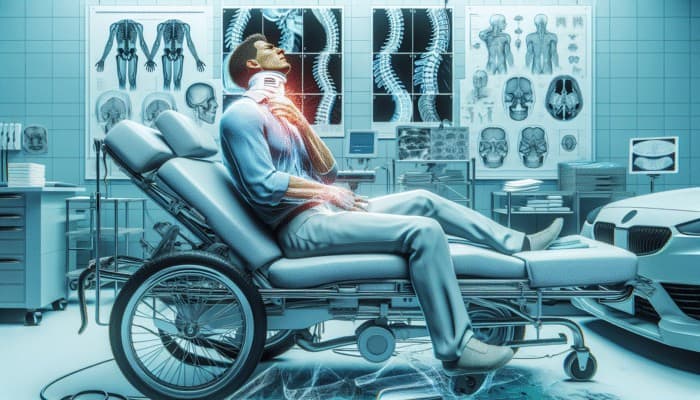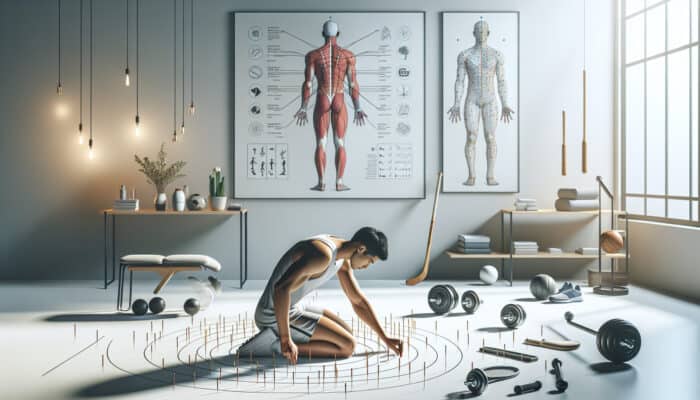Comprehensive Insights into Whiplash and the Role of Acupuncture
Defining Whiplash: Causes and Symptoms

Whiplash is a prevalent yet frequently misinterpreted neck injury, primarily resulting from a swift back-and-forth motion of the head, akin to the snap of a whip. This condition is commonly associated with car accidents, where abrupt deceleration forces the neck into an unnatural position. However, whiplash can also be a consequence of sports injuries, physical assault, or falls. Often, symptoms such as neck pain, stiffness, and headaches may not manifest immediately, underscoring the importance for individuals to remain vigilant about any discomfort following such incidents.
The mechanics behind whiplash involve the overstretching of ligaments and muscles in the neck, which leads to inflammation and discomfort. Within the UK, it ranks among the leading causes of chronic pain, significantly affecting daily life. Many individuals face not only the physical ramifications but also emotional stress and anxiety due to their inability to perform routine activities. The multifaceted nature of this injury necessitates a thorough treatment approach that addresses both physical and psychological elements to foster complete recovery.
Exploring How Acupuncture Provides Relief
Acupuncture, a foundational element of traditional Chinese medicine, presents a holistic strategy for alleviating symptoms linked with whiplash. By focusing on specific points throughout the body, acupuncture stimulates the nervous system and promotes the release of natural pain-relieving substances, such as endogenous endorphins. This therapy not only reduces pain but also enhances mobility in the affected area, providing a pathway to recovery.
The practice of acupuncture involves the insertion of fine needles into designated acupuncture points, which are believed to correspond to various organs and systems within the body. In the context of whiplash recovery, practitioners concentrate on points that alleviate neck pain and induce relaxation. This ancient technique offers a non-invasive alternative to pain relief, appealing to those who wish to avoid pharmaceuticals or invasive procedures, and highlights the growing interest in holistic healing methods.
Research supports the efficacy of acupuncture in managing pain and enhancing mobility for patients suffering from whiplash. Notably, a systematic review of clinical studies has showcased acupuncture's effectiveness in diminishing pain intensity and improving the overall quality of life for individuals experiencing whiplash-associated disorders. By improving blood circulation and reducing inflammation, acupuncture serves as a robust ally in the recovery process.
The Multifaceted Benefits of Acupuncture for Whiplash Recovery
The therapeutic advantages of acupuncture in the context of whiplash recovery extend far beyond simple pain alleviation. For those grappling with the persistent effects of whiplash, acupuncture provides a natural solution that encourages healing from within. One of its primary benefits is the reduction of inflammation, a frequent contributor to chronic pain conditions. By minimising inflammation around the injured soft tissues, acupuncture accelerates the healing process and promotes overall recovery.
Furthermore, acupuncture significantly impacts the restoration of mobility. Many patients report an enhanced range of motion in their necks following treatment, allowing them to engage in daily activities with greater ease. The relaxation that accompanies acupuncture sessions also alleviates the psychological burden related to chronic pain, fostering improved mental well-being and resilience during the recovery journey.
Additionally, acupuncture is a versatile treatment option, with a variety of techniques available to customise therapy to individual needs. Techniques such as electroacupuncture, which combines traditional acupuncture with electrical stimulation, can further amplify pain relief and muscle relaxation. The adaptability of acupuncture positions it as a vital component of a comprehensive treatment plan for whiplash recovery, ensuring that each patient receives tailored care.
Diverse Acupuncture Techniques for Effective Whiplash Treatment

Within the realm of acupuncture, several techniques can be employed to optimise benefits for whiplash recovery. Traditional acupuncture remains the most commonly practised method, involving the precise insertion of fine needles into specific acupoints based on the patient's symptoms and overall health profile. This tailored approach ensures that each treatment is uniquely suited to the individual's needs.
Electroacupuncture is gaining traction as a complementary technique to traditional methods. This innovative approach applies electrical impulses to the needles, enhancing the stimulation of nerve endings. It is particularly beneficial for patients experiencing severe pain or tension, as it encourages deeper muscle relaxation and pain relief, facilitating a more effective recovery process.
Another noteworthy technique is cupping therapy, which can complement acupuncture for whiplash. In this method, vacuum-sealed cups are applied to the skin to create suction, drawing blood to the surface and alleviating muscle tension while promoting circulation. Many patients find that the combination of acupuncture and cupping enhances their overall sense of well-being and expedites recovery.
Furthermore, practitioners may incorporate moxibustion, a technique utilising the herb mugwort to warm acupuncture points. This method can improve blood flow and further relax tight muscles, creating a comprehensive approach to whiplash recovery that addresses each patient's unique requirements through diverse therapeutic techniques.
Clinical Evidence Supporting the Effectiveness of Acupuncture
Recent clinical studies provide robust evidence supporting the efficacy of acupuncture in treating whiplash-associated disorders. Research, including systematic reviews and randomised controlled trials, consistently demonstrates that acupuncture can lead to significant reductions in pain intensity and notable improvements in functional outcomes. A landmark study conducted in the UK revealed that patients receiving acupuncture reported a substantial decrease in pain compared to those receiving standard medical treatments.
Moreover, acupuncture has been shown to reduce the incidence of chronic pain and disability following whiplash injuries. A study published in a reputable medical journal indicated that patients who underwent acupuncture were less likely to experience long-term complications compared to those who did not pursue acupuncture treatment. This evidence underscores the critical importance of considering acupuncture as a primary treatment option for effective whiplash recovery.
Additionally, the World Health Organisation (WHO) has acknowledged acupuncture as an effective treatment modality for various pain-related conditions, further solidifying its role in managing whiplash symptoms. With growing public and professional interest in holistic therapies, the evidence base supporting acupuncture continues to evolve, paving the way for its integration into standard care practices across the UK.
Accessing Acupuncture Treatments Across the UK
Locating Qualified Acupuncturists for Whiplash Recovery
When seeking acupuncture for whiplash recovery, it is imperative to locate qualified practitioners who adhere to stringent safety standards and professional guidelines. In the UK, the British Acupuncture Council (BAcC) maintains a register of accredited practitioners, ensuring that patients are treated by skilled acupuncturists who have completed extensive training and adhere to a strict code of conduct.
Patients can visit the BAcC website to find registered acupuncturists in their vicinity. It is advisable to check the practitioner's credentials, experience, and specialisation in treating pain conditions such as whiplash. Additionally, many acupuncturists offer initial consultations, allowing individuals to discuss their symptoms and treatment goals before commencing therapy, thus ensuring a tailored approach to their recovery.
In recent years, there has been a significant shift towards the acceptance of acupuncture within mainstream healthcare. Many practitioners emphasise the importance of evidence-based practices, ensuring that treatments are customised to meet each individual's unique needs. Consequently, patients can anticipate a personalised approach that considers their specific circumstances, ultimately enhancing the efficacy of the treatment.
NHS Perspectives on Acupuncture as a Treatment Option
In the UK, the National Health Service (NHS) has started to recognise acupuncture as a valid treatment option for various conditions, including chronic pain and whiplash recovery. However, availability varies significantly across different regions and NHS trusts. Some trusts provide acupuncture services as part of their pain management programmes, while others may not offer this treatment at all.
Patients interested in NHS-supported acupuncture are encouraged to consult their general practitioners (GPs). GPs can provide referrals to acupuncturists within the NHS framework or recommend practitioners in the private sector. This integrated approach allows patients to access high-quality acupuncture services while ensuring their treatment aligns with other medical care they may be receiving.
It is essential to note that while NHS-accredited acupuncture may offer financial relief, the number of sessions covered could be limited. Consequently, many individuals opt for private acupuncture treatment, which can provide a more comprehensive and extended treatment plan tailored to their specific recovery needs.
Understanding the Cost and Insurance Coverage for Acupuncture
The cost of acupuncture treatments throughout the UK can vary significantly based on factors such as location, practitioner experience, and duration of treatment. On average, private sessions may range from £40 to £80 per appointment. Some practitioners offer package deals or discounts for multiple sessions, making ongoing treatment for whiplash recovery more accessible to individuals seeking continuous care.
Numerous private health insurance plans provide coverage for acupuncture treatments, although specific policies may differ. Patients are encouraged to check with their insurance providers to understand what is encompassed within their plan. This can significantly alleviate the financial burden associated with acupuncture treatments, allowing individuals to focus on their recovery without the added stress of financial constraints.
As holistic therapies gain popularity, the willingness of insurance companies to cover acupuncture highlights its increasing acceptance as a legitimate treatment modality. With ongoing advocacy and research, it is likely that more individuals will gain access to acupuncture for whiplash recovery, reinforcing its role within comprehensive pain management strategies.
Real-Life Case Studies and Patient Testimonials
Inspiring Success Stories Across the UK
Throughout the UK, numerous patients have shared their transformative success stories following acupuncture treatments for whiplash recovery. One particularly compelling account comes from Sarah, a 32-year-old marketing professional who endured debilitating neck pain after a car accident. Initially sceptical about acupuncture, Sarah decided to try it after conventional treatments failed to provide relief. After just a few sessions, she reported substantial improvements in her pain levels and mobility, praising the holistic approach of acupuncture.
Another inspiring narrative involves Tom, a former athlete in his forties who suffered from chronic whiplash for over a year. Tom's rigorous training was disrupted by his injury, impacting both his physical performance and mental state. After incorporating acupuncture into his rehabilitation plan, he experienced a remarkable turnaround, stating that the treatment not only alleviated his pain but also restored his confidence and ability to train effectively.
These success stories reflect a broader trend within the UK, where more individuals are finding relief through acupuncture. As patients continue to share their experiences, they create a supportive community that encourages others facing similar challenges in their recovery journey.
Patient Experiences: Empowerment Through Acupuncture
Experiences of patients who have undergone acupuncture vary, yet many UK residents express sentiments of relief and gratitude. A common theme among those who have sought acupuncture for whiplash is the empowerment that comes from taking control of their healing process. Many patients describe their sessions as moments of relaxation and mindfulness, providing not only physical benefits but also a mental reprieve from life's stresses.
One patient, Emma, recounted her journey through whiplash recovery, highlighting how acupuncture transformed her perspective on pain management. Emma emphasised the significance of the practitioner-patient relationship, noting that her acupuncturist took the time to listen to her concerns and customise treatments to her specific needs. This personalised approach made Emma feel valued and understood, enhancing the overall effectiveness of her treatment.
Moreover, patients frequently mention the supportive environment offered by acupuncture clinics. Many find that the calming atmosphere is conducive to healing, with practitioners often encouraging open discussions about symptoms and progress. This dialogue fosters trust and motivates patients to remain engaged in their recovery journey.
Long-Term Advantages of Acupuncture for Whiplash Recovery
The long-term benefits of acupuncture in the context of whiplash recovery extend far beyond mere immediate pain relief. Research conducted in the UK has demonstrated that patients who undergo acupuncture treatment not only experience reduced pain but also witness improved overall function and quality of life. This advantage is particularly noteworthy in scenarios where conventional treatments yield limited results.
Studies indicate that acupuncture can lead to sustained enhancements in neck mobility and a decreased likelihood of developing chronic pain. A longitudinal study involving UK patients revealed that those who received acupuncture were less prone to report persistent pain compared to those who did not engage in acupuncture therapy. This finding underscores the role of acupuncture as a preventative measure against long-term complications associated with whiplash.
Furthermore, the holistic nature of acupuncture fosters a sense of well-being that can yield lasting effects. Patients often report improved mood and reduced anxiety levels, contributing to a more resilient approach to recovery. As individuals learn to manage their pain and stress through acupuncture, they are better equipped to navigate the challenges of daily life, ultimately enhancing their overall quality of life.
Integrating Acupuncture with Complementary Therapies
The Synergy Between Physiotherapy and Acupuncture
The integration of acupuncture with physiotherapy represents a powerful and effective approach to whiplash recovery in the UK. While acupuncture focuses on alleviating pain and promoting healing through the stimulation of specific points, physiotherapy provides a comprehensive strategy for restoring movement and function. The combination of these two therapies can lead to accelerated recovery and significantly enhanced outcomes for patients.
Physiotherapists frequently incorporate acupuncture into their treatment plans, particularly for individuals dealing with chronic pain. By complementing traditional physiotherapy techniques—such as manual therapy and tailored exercises—with acupuncture, practitioners can more effectively target pain relief, resulting in higher patient satisfaction levels. Many patients find that acupuncture alleviates muscle tension, making it easier to engage in physiotherapy exercises and improving overall rehabilitation efforts.
Moreover, the collaboration between acupuncturists and physiotherapists fosters a multidisciplinary approach to treatment. This teamwork ensures that every aspect of the patient's recovery is addressed, promoting not only physical healing but also emotional well-being. As healthcare providers increasingly recognise the benefits of integrative approaches, patients can expect more cohesive and effective treatment plans tailored to their unique needs.
Chiropractic Care and Acupuncture: A Holistic Approach
Chiropractic care and acupuncture share a mutual goal of promoting healing and restoring function, making them complementary therapies for whiplash recovery. Chiropractors often recommend acupuncture as part of a comprehensive treatment plan, recognising its efficacy in alleviating pain and enhancing mobility for patients with whiplash-related injuries.
The combination of chiropractic adjustments and acupuncture can yield synergistic benefits. Chiropractic care focuses on aligning the spine and musculoskeletal system, while acupuncture addresses the body's energy pathways and promotes relaxation. By integrating both approaches, patients may experience improved pain relief and a more effective recovery process.
For individuals seeking a holistic path to whiplash treatment, the combination of chiropractic care and acupuncture offers a well-rounded option. Patients benefit from the expertise of both practitioners, creating a collaborative environment that nurtures healing and enhances recovery outcomes. UK chiropractors are increasingly incorporating acupuncture into their practices, reflecting a broader trend towards integrative healthcare solutions.
Comprehensive Pain Management Strategies for Whiplash
Acupuncture can serve as a valuable component of a broader pain management strategy for individuals suffering from whiplash in the UK. Many patients discover that incorporating acupuncture alongside other pain management techniques enhances their overall experience and treatment outcomes. This multifaceted approach enables individuals to take control of their recovery journey while effectively addressing the complexities of their pain.
In addition to acupuncture, patients may explore options such as physical therapy, medication, and proactive lifestyle modifications. Engaging in regular exercise, maintaining a nutritious diet, and managing stress through mindfulness practices can all contribute to improved pain management. By adopting a holistic perspective, patients can develop a comprehensive strategy that addresses not only the physical aspects of whiplash but also the emotional and psychological factors involved in their recovery.
Furthermore, support from healthcare providers plays a crucial role in developing effective pain management strategies. Practitioners can offer guidance on integrating various treatments, ensuring that patients receive personalised care that meets their unique needs. As more individuals embrace integrative approaches to pain management, the potential for successful recovery from whiplash continues to expand.
Ensuring Safety and Regulatory Compliance in Acupuncture Practices
Regulatory Bodies Overseeing Acupuncture in the UK
In the UK, the practice of acupuncture is governed by the British Acupuncture Council (BAcC), which establishes stringent standards for practitioners to ensure patient safety and high-quality care. Membership with the BAcC signifies a practitioner’s credibility, indicating that they have undergone rigorous training and adhere to professional guidelines. This regulatory framework instills confidence in patients seeking acupuncture for whiplash recovery, ensuring they receive care from qualified professionals.
The BAcC also plays a crucial role in promoting best practices within the profession. They offer ongoing education and training for acupuncturists, ensuring practitioners remain current with the latest research and techniques. This commitment to continuous professional development ultimately enhances the overall standards of acupuncture practice in the UK, benefiting patients seeking treatment.
Additionally, regulatory bodies focus on establishing clear ethical guidelines for practitioners, ensuring that patient welfare remains the top priority. Patients can feel secure knowing that acupuncturists are held accountable for their practices, fostering a culture of trust and transparency within the acupuncture community.
Upholding Safety Protocols in Acupuncture Treatments
Safety is paramount when it comes to acupuncture treatments, particularly for individuals seeking relief from conditions such as whiplash. In the UK, registered acupuncturists adhere to strict hygiene and safety protocols to ensure patient well-being during treatments. This includes the use of sterile needles, maintaining a clean treatment environment, and complying with health and safety regulations.
Practitioners are thoroughly trained to assess patients before treatment commences, ensuring that acupuncture is suitable for their specific condition. This assessment includes a comprehensive discussion of medical history, current symptoms, and any potential contraindications. By taking these precautions, acupuncturists can minimise the risk of complications and provide safe, effective care.
Moreover, patients are encouraged to communicate openly with their practitioners about any concerns or discomfort they may encounter during treatment. Practitioners are well-equipped to address these concerns and adjust their techniques as necessary, prioritising patient comfort and safety throughout the process.
Understanding Potential Side Effects of Acupuncture
While acupuncture is generally regarded as safe, patients should be aware of potential side effects that may arise during treatment. Common side effects include minor bruising, soreness, or temporary discomfort at the needle insertion sites. These effects are typically mild and resolve quickly; however, patients should communicate any unusual or persistent symptoms to their practitioners for further evaluation.
In rare instances, individuals may experience dizziness or fainting during or after acupuncture sessions. This reaction is often attributed to anxiety or inadequate nourishment prior to treatment. Patients are advised to consume a light meal and remain hydrated before their sessions to minimise the risk of such occurrences.
Overall, the likelihood of experiencing serious side effects from acupuncture is minimal, especially when treatment is administered by a qualified and experienced practitioner. Awareness of potential side effects empowers patients to make informed decisions, allowing them to take charge of their health and recovery journey.
Reporting Adverse Events in Acupuncture Practice
In the UK, the reporting of adverse events related to acupuncture is a crucial aspect of maintaining high safety standards within the profession. Registered acupuncturists are mandated to report any adverse events to relevant regulatory bodies, such as the British Acupuncture Council. This accountability ensures that practitioners uphold best practices and fosters a culture of transparency within the field.
The reporting process facilitates continuous monitoring of acupuncture's safety and efficacy, enabling regulatory bodies to identify trends and implement necessary changes. By collecting data on adverse events, practitioners can refine their techniques and enhance patient care, ultimately improving outcomes for individuals seeking treatment for conditions like whiplash.
Patients should feel empowered to ask their practitioners about safety protocols and the reporting process. Open communication fosters trust and ensures that patients are informed about the measures in place to safeguard their health during acupuncture treatments.
Envisioning the Future of Acupuncture in the UK
Advancements in Research and Development
The future of acupuncture in the UK is characterised by ongoing research and development aimed at validating the therapy's effectiveness for various conditions, including whiplash. With an expanding body of evidence supporting acupuncture, researchers are exploring innovative methods to enhance treatment outcomes and broaden its application across numerous medical fields.
Current studies are focused on understanding the underlying mechanisms that contribute to acupuncture’s effectiveness, particularly in the realm of pain management. Research institutions and universities are conducting clinical trials to investigate the specific physiological changes that take place during acupuncture treatment. This scientific exploration not only bolsters acupuncture's credibility but also paves the way for its integration into mainstream healthcare practices.
Moreover, interdisciplinary collaborations between acupuncturists, medical professionals, and researchers are becoming increasingly prevalent. These partnerships foster a comprehensive understanding of acupuncture's role in patient care, ensuring that practitioners remain well-informed about the latest advancements in both acupuncture and conventional medicine.
Enhancing Training and Education in Acupuncture
As the demand for acupuncture continues to rise, UK institutions are expanding training programmes to cultivate a new generation of qualified acupuncturists. Comprehensive training emphasises both theoretical knowledge and practical skills, ensuring that future practitioners are well-equipped to provide safe and effective care.
Institutions offering acupuncture training adhere to the guidelines set forth by regulatory bodies, ensuring that graduates meet the necessary standards for obtaining membership with organisations like the British Acupuncture Council. This commitment to quality education enhances the overall reputation of the profession and instils confidence in patients seeking treatment.
In addition to formal education, ongoing professional development is encouraged among acupuncturists. Workshops, seminars, and conferences provide opportunities for practitioners to stay abreast of the latest research and techniques, ultimately benefiting patients who seek innovative and effective treatments for their conditions.
Increasing Public Awareness and Acceptance of Acupuncture
In recent years, public awareness and acceptance of acupuncture as a legitimate treatment modality have surged in the UK. Patients are becoming more informed about the advantages of acupuncture for various conditions, including whiplash, and are actively seeking practitioners to explore their options.
This growing acceptance is reflected in media coverage, where positive reports on acupuncture’s effectiveness have contributed to its rising popularity. As more success stories come to light, individuals are encouraged to consider acupuncture as a viable alternative to conventional treatments and therapies.
Moreover, community outreach initiatives and educational programmes are playing a vital role in demystifying acupuncture for the public. Workshops, demonstrations, and informational sessions offer valuable insights into the practice, enabling individuals to make informed decisions about their healthcare options and treatment pathways.
Integrating Acupuncture into NHS Services
The integration of acupuncture into NHS services signifies a significant advancement for patient access to holistic therapies in the UK. As healthcare providers increasingly acknowledge the value of complementary therapies, many NHS trusts are investigating ways to incorporate acupuncture into their pain management programmes.
Including acupuncture as part of standard care for conditions such as whiplash can provide patients with a well-rounded approach to recovery. This integration enhances patient outcomes and alleviates the burden on conventional treatments, facilitating a more efficient use of healthcare resources while supporting patient-centred care.
As discussions surrounding the integration of acupuncture into NHS services continue, patients can look forward to a future where holistic therapies are readily available as part of their treatment options. This shift reflects a growing trend towards patient empowerment and autonomy in choosing their preferred methods of healing and recovery.
Establishing a Robust Regulatory Framework for Acupuncture
Developing a robust regulatory framework for acupuncture practices in the UK is essential for ensuring patient safety and maintaining high standards of care. As acupuncture gains recognition as a legitimate treatment modality, regulatory bodies are working to establish comprehensive guidelines that govern its practice.
This framework will delineate the qualifications necessary for practitioners, the protocols for treatment, and the standards for ensuring patient safety. By implementing clear regulations, patients can feel assured of the quality of care they receive from acupuncturists, fostering a sense of trust and security in the treatment process.
Furthermore, ongoing collaboration between regulatory bodies, educational institutions, and practitioners will be vital in shaping the future of acupuncture in the UK. This collective effort will ensure that the profession continues to evolve, meeting the needs of patients and adapting to the ever-changing landscape of healthcare.
Frequently Asked Questions About Acupuncture
What is acupuncture and how does it work?
Acupuncture is a traditional Chinese medicine practice that involves the insertion of fine needles into specific points on the body to promote healing and alleviate pain. It aims to balance the body's energy and stimulate natural healing processes.
How does acupuncture assist in whiplash recovery?
Acupuncture stimulates the nervous system, promoting the release of natural pain-relieving chemicals and reducing inflammation, thus aiding in the recovery process for individuals suffering from whiplash.
Is acupuncture a safe treatment option for whiplash?
Yes, when performed by qualified practitioners, acupuncture is generally safe. It has minimal risks, and any potential side effects are typically mild and temporary, making it a reliable option for treating whiplash.
How can I find a qualified acupuncturist in the UK?
To find a qualified acupuncturist, look for practitioners registered with the British Acupuncture Council (BAcC) or seek recommendations from healthcare providers familiar with acupuncture services.
Will the NHS cover acupuncture treatments?
The availability of acupuncture through the NHS varies by region. Some Trusts offer it for specific conditions, including whiplash, while others may not provide this treatment option at all.
What is the typical cost of acupuncture in the UK?
The cost of private acupuncture sessions generally ranges from £40 to £80 per appointment, depending on the practitioner's experience and geographic location. Many clinics also offer package deals for multiple sessions.
Can acupuncture be effectively combined with other therapies?
Yes, acupuncture can be effectively integrated with physiotherapy, chiropractic care, and other pain management strategies to enhance recovery from whiplash and improve overall patient outcomes.
Are there any side effects associated with acupuncture?
While potential side effects of acupuncture are rare, they may include minor bruising, soreness, or temporary discomfort at the needle sites. Most side effects are mild and resolve quickly.
How long does it usually take to see results from acupuncture?
The time required to see results varies by individual. Many patients report improvements within just a few sessions, while others may require ongoing treatment for optimal results.
Is acupuncture effective for long-term pain management?
Yes, studies indicate that acupuncture can lead to sustained improvements in pain management and overall function, making it a valuable option for individuals seeking long-term care for whiplash injuries.
























1 Comment
You’ve brought up such an important topic with whiplash—it’s one of those injuries that can really fly under the radar. I’ve had a close friend who experienced whiplash after a minor fender bender; it wasn’t until weeks later that they started feeling the pain. It’s a reminder of how often we overlook our bodies’ signals after an accident.